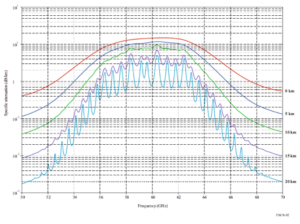Being one of the major players within WiGig infrastructure solutions, it has become clear that there are different ways to look upon different solutions and compare them as objective as possible. This blog post intends to demystify, clarify and quantify the value higher performance creates for the total solution.
First of all, most of the existing WiGig solutions available on the market today originates from the indoor use case where massive amounts of data were to be transferred over short distance without the use of wires or cables. Typically, the scenario is to provide wireless connections between a laptop and a server or hard drive for quick backup or for connection between the set top box and the internet, to achieve HD or 4K video streaming or any other type of use case where you would benefit from multi-Gigabit transmission over the air. Since this is one of the larger potential consumer applications for WiGig, a lot of effort has been put into developing products that would support these use cases. Initially, we could see big semiconductor companies like Intel, Qualcomm and Broadcom coming up with optimized solutions based on CMOS technology, since this technology gave adequate performance with very low cost per unit in volumes of 100 million units.
In a WiGig solution you typically have one part that manages the data on baseband level, taking care of modulation of the signal and preparing it for further transmission on RF frequencies, and one part that convert the baseband signal into a higher RF frequency (in the WiGig case it is converted up to app 60 GHz). The technology choices for the baseband part and the RF part depend on different requirements and challenges to overcome. Today the baseband part is dominated by digital technology, and the RF part is dominated by analog technology.
For the RF part it is widely accepted that there are pros and cons with respect to various semiconductor technologies that are commercially available for millimeter wave applications today. A comparison is provided in table 1 below, where three different basic technologies are compared, RF CMOS, Silicon Germanium/BiCMOS (SiGe) and Gallium Arsenide (GaAs). In short you could say that CMOS require a very high initial investment but very low cost per chip in production and the RF performance is starting to degrade when you approach frequencies around 60 GHz. GaAs, on the other hand has very good performance at higher frequencies and a very low initial technology investment, but the high cost per chip in production is a major drawback in high volume scenarios, like WiGig applications. Also the lack of any digital parts, makes GaAs almost impossible to use due to lack of integration level that is needed for these kinds of chips. SiGe offers a good tradeoff between price and performance with initial medium investment cost, and a quite low cost per chip in production and very good performance on millimeter wave frequencies. It also enables a greater integration level of digital parts onto the same silicon.

Table 1. High level comparison RF technologies.
In the WiGig scenario, we do not see any GaAs solutions so the game is between the CMOS technology and the SiGe technology. Without digging too deep into the “nitty gritty” details of technologies, let’s convert the differences into what can be appreciated without the need of a PhD.
A CMOS based WiGig solution typically transmit an output power of app 60 microwatt to 1 milliwatt per RF channel. The comparable figure for the Sivers IMA SiGe based solution is app 16 milliwatt, which is between 20 to 270 times higher output power compared to typical market offerings. In the US FCC regulations [1], it is stipulated a maximum total power that can be transmitted from a system. For the 60 GHz, the total allowed aggregated output power in general is 10W. Excluding the typical antenna gain, the RF portion is allowed to transmit app 40 milliwatt, which is achieved by combining several RF channels on the same chip.
For the typical CMOS chipset, this is achieved by using a 4 level or 16-level modulation scheme, giving up to 4,6 Gbps of data throughput. There is however, no available CMOS based solutions that provide 64-level modulation schemes supporting up to 7 Gbps throughput and if there were support for it, the transmitted output power would be much lower than the 40 milliwatt stated above. It typically would be something in the order of 10 milliwatt, since you need to back off the output power to have enough performance to support higher order modulation. The SiGe based solution from Sivers IMA supports the maximum transmitted output power also for the higher order modulations schemes, which means it reaches further. The option, to be on par with the Sivers IMA solution, would be to combine several chipsets and/or increase the size of the antenna to get higher output power. The drawback is that this drives cost and complexity and the benefit of low cost CMOS chipsets thus disappears.
In the RF domain, higher output power means longer reach, but also the specific choice of frequency has great impact on how far you can reach with your signal. The WiGig standard cover the 57-64 GHz frequency band, which is suitable for short haul, indoor applications. Around 60 GHz, the atmospheric attenuation due to oxygen molecules has a major impact on the reach of the signal. As can be seen in figure 1 below, there is at least 10 dB less attenuation if you can transmit the signal on 66 GHz instead of 60 GHz.

Figure 1. Specific attenuation in the range 50-70 GHz at the altitudes indicated, calculated at intervals of 10 MHz, including line centres (0 km, 5 km, 10 km, 15 km and 20 km). Extract from Rec. ITU-R P.676-11.
There are regional differences in how you can apply 60 GHz technology, which has an impact on how widely the technology can be used. There is a difference in what power you can transmit and there is a difference in how wide the used frequency band can be to be used around 60 GHz. Typically, 57-64 GHz is applied in Europe [2], 57-66 GHz in Japan [3] and 57-71 GHz in the US [1]. Within the industry, work is going on within ETSI to address and make it easier to use millimeter wave technologies and it is expected that we will see a global harmonization with respect to these variations. Today, Sivers IMA’s WiGig RFIC supports the frequency regulations for all regions, which is a unique advantage compared to any other supplier.
In real life with comparable conditions (with respect to rain intensity, expected availability of the connection etc.) the choice of frequency could be the difference between reaching 250 meters or 350 meters. Since a WiGig system, with its beam steering capabilities, typically cover a 90-degree sector, the covered area could be doubled! With potential end-users evenly distributed over the addressable area, you would e.g. reach twice as many customers with a system using 66 GHz than a system using 60 GHz.
As Sivers IMA defined, designed and developed the WiGig RF product specifically to meet the tougher requirements from outdoor infrastructure solutions, the SiGe technology base was selected and thus, superior performance has been achieved. It was also a deliberate choice to design a product that cover more than the traditional WiGig frequency band of 57-64 GHz to support longer reach and more robust performance.
For outdoor applications with focus on infrastructure use cases, performance is key. By combining better output power capabilities with the flexibility to use frequencies above 64 GHz, which is provided by the Sivers IMA solution, it is possible to provide greater data throughput over longer distance to more customers at a lower total cost. In short, better performance will be cheaper!
Patric Erlandsson
VP Sales & Marketing
Sivers IMA
Ref [1] https://apps.fcc.gov/edocs_public/attachmatch/FCC-16-89A1.pdf
Ref [2]http://www.erodocdb.dk/Docs/doc98/official/pdf/REC0901.PDF
Ref [3] http://www.tele.soumu.go.jp/resource/e/search/myuse/use0303/10g.pdf
Ref [4] https://www.itu.int/dms_pubrec/itu-r/rec/p/R-REC-P.676-11-201609-I!!PDF-E.pdf
![]()

